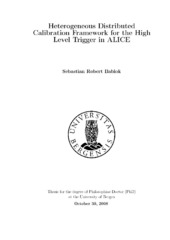| dc.description.abstract | This thesis focusses on the development of a distributed and re-configurable online calibration environment for the ALICE (A Large Ion Collider Experiment) HLT (High Level Trigger). ALICE1 is one of the four major experiments at the new accelerator ring (Large Hadron Collider - LHC) at CERN in Geneva (CH). The experiment is laid out to investigate the properties of strongly interacting matter created in heavy ion collisions at ultra-relativistic energies. It is assumed that the universe consisted of such a state of matter shortly after the Big Bang. The HLT is a sub-system of ALICE, focussing on online event reconstruction and analysis, event selection and data reduction. These tasks are executed on a large computing farm close to the experiment. To achieve high accuracy in the analysis, calibration is a major issue for the software components running in the HLT. The thesis describes the interfaces and components developed for the HLT calibration framework. These interfaces cover the data exchange with the other ALICE sub-systems connected to the HLT. Their purpose is to provide calibration and condition settings to the HLT and to send freshly produced calibration objects to the destined targets. The exchange of data also requires synchronisation with the other sub-systems and within HLT itself. The interfaces (described in chapter 4.3, 4.4 and 4.5) and their interplay (depicted in chapter 5), as well as the FED-API (Front-End- Device-API) (specified in chapter 3) have been the main effort during this PhD project. How well they meet the imposed requirements is presented in the summary and outlook in chapter 6. The outline of this thesis is the following: In the first chapter a very brief overview of the physics goal of the experiment is given. ALICE with its detectors and systems is presented in chapter two. Chapter three focusses on the FED-API, which deals with the connection of the ALICE DCS (Detector Control System) to the Front-End- Electronics (FEE) of the different detectors. The FED-API is (re-)used for the HLT as well. The different parts constituting the HLT calibration framework, – interfaces and their related components – are described in detail in chapter four. They are the main topic of the thesis. Especially the heterogeneity of the connected systems and the diversity of the used mechanisms are major aspects. Chapter five joins the different constituents and displays their interaction and synchronisation procedures. Moreover, examples for the usage of the HLT calibration framework and benchmarks for dedicated interfaces are presented. Finally, the results are summarised and an outlook on further developments and enhancements is given in chapter six. The appendix covers the usage of the presented interfaces. The calibration framework for the ALICE HLT, as it is described here, refers to the state of Autumn 2008. | en_US |
